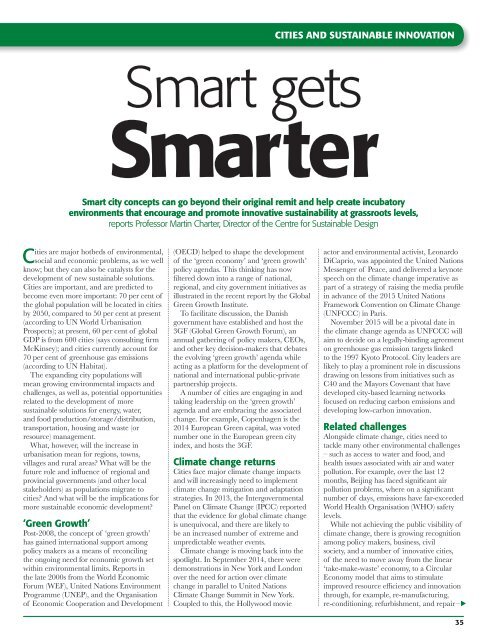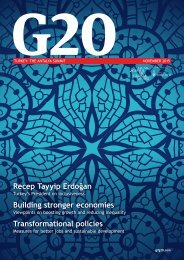SOURCE: Sustainable Development
SOURCE Sustainable Development magazine will be exploring the post 2015 international development landscape. It will engage the private sector to drive innovation and support the ever growing need to achieve the UN Sustainable Development goal’s
SOURCE Sustainable Development magazine
will be exploring the post 2015 international
development landscape.
It will engage the private sector to drive
innovation and support the ever growing
need to achieve the UN Sustainable
Development goal’s
You also want an ePaper? Increase the reach of your titles
YUMPU automatically turns print PDFs into web optimized ePapers that Google loves.
CITIES AND SUSTAINABLE INNOVATION<br />
Smart gets<br />
Smarter<br />
Smart city concepts can go beyond their original remit and help create incubatory<br />
environments that encourage and promote innovative sustainability at grassroots levels,<br />
reports Professor Martin Charter, Director of the Centre for <strong>Sustainable</strong> Design<br />
Cities are major hotbeds of environmental,<br />
social and economic problems, as we well<br />
know; but they can also be catalysts for the<br />
development of new sustainable solutions.<br />
Cities are important, and are predicted to<br />
become even more important: 70 per cent of<br />
the global population will be located in cities<br />
by 2050, compared to 50 per cent at present<br />
(according to UN World Urbanisation<br />
Prospects); at present, 60 per cent of global<br />
GDP is from 600 cities (says consulting firm<br />
McKinsey); and cities currently account for<br />
70 per cent of greenhouse gas emissions<br />
(according to UN Habitat).<br />
The expanding city populations will<br />
mean growing environmental impacts and<br />
challenges, as well as, potential opportunities<br />
related to the development of more<br />
sustainable solutions for energy, water,<br />
and food production/storage/distribution,<br />
transportation, housing and waste (or<br />
resource) management.<br />
What, however, will the increase in<br />
urbanisation mean for regions, towns,<br />
villages and rural areas? What will be the<br />
future role and influence of regional and<br />
provincial governments (and other local<br />
stakeholders) as populations migrate to<br />
cities? And what will be the implications for<br />
more sustainable economic development?<br />
‘Green Growth’<br />
Post-2008, the concept of ‘green growth’<br />
has gained international support among<br />
policy makers as a means of reconciling<br />
the ongoing need for economic growth set<br />
within environmental limits. Reports in<br />
the late 2000s from the World Economic<br />
Forum (WEF), United Nations Environment<br />
Programme (UNEP), and the Organisation<br />
of Economic Cooperation and <strong>Development</strong><br />
(OECD) helped to shape the development<br />
of the ‘green economy’ and ‘green growth’<br />
policy agendas. This thinking has now<br />
filtered down into a range of national,<br />
regional, and city government initiatives as<br />
illustrated in the recent report by the Global<br />
Green Growth Institute.<br />
To facilitate discussion, the Danish<br />
government have established and host the<br />
3GF (Global Green Growth Forum), an<br />
annual gathering of policy makers, CEOs,<br />
and other key decision-makers that debates<br />
the evolving ‘green growth’ agenda while<br />
acting as a platform for the development of<br />
national and international public-private<br />
partnership projects.<br />
A number of cities are engaging in and<br />
taking leadership on the ‘green growth’<br />
agenda and are embracing the associated<br />
change. For example, Copenhagen is the<br />
2014 European Green capital, was voted<br />
number one in the European green city<br />
index, and hosts the 3GF.<br />
Climate change returns<br />
Cities face major climate change impacts<br />
and will increasingly need to implement<br />
climate change mitigation and adaptation<br />
strategies. In 2013, the Intergovernmental<br />
Panel on Climate Change (IPCC) reported<br />
that the evidence for global climate change<br />
is unequivocal, and there are likely to<br />
be an increased number of extreme and<br />
unpredictable weather events.<br />
Climate change is moving back into the<br />
spotlight. In September 2014, there were<br />
demonstrations in New York and London<br />
over the need for action over climate<br />
change in parallel to United Nations<br />
Climate Change Summit in New York.<br />
Coupled to this, the Hollywood movie<br />
actor and environmental activist, Leonardo<br />
DiCaprio, was appointed the United Nations<br />
Messenger of Peace, and delivered a keynote<br />
speech on the climate change imperative as<br />
part of a strategy of raising the media profile<br />
in advance of the 2015 United Nations<br />
Framework Convention on Climate Change<br />
(UNFCCC) in Paris.<br />
November 2015 will be a pivotal date in<br />
the climate change agenda as UNFCCC will<br />
aim to decide on a legally-binding agreement<br />
on greenhouse gas emission targets linked<br />
to the 1997 Kyoto Protocol. City leaders are<br />
likely to play a prominent role in discussions<br />
drawing on lessons from initiatives such as<br />
C40 and the Mayors Covenant that have<br />
developed city-based learning networks<br />
focused on reducing carbon emissions and<br />
developing low-carbon innovation.<br />
Related challenges<br />
Alongside climate change, cities need to<br />
tackle many other environmental challenges<br />
– such as access to water and food, and<br />
health issues associated with air and water<br />
pollution. For example, over the last 12<br />
months, Beijing has faced significant air<br />
pollution problems, where on a significant<br />
number of days, emissions have far-exceeded<br />
World Health Organisation (WHO) safety<br />
levels.<br />
While not achieving the public visibility of<br />
climate change, there is growing recognition<br />
among policy makers, business, civil<br />
society, and a number of innovative cities,<br />
of the need to move away from the linear<br />
‘take-make-waste’ economy, to a Circular<br />
Economy model that aims to stimulate<br />
improved resource efficiency and innovation<br />
through, for example, re-manufacturing,<br />
re-conditioning, refurbishment, and repair –<br />
35<br />
▲<br />
SSD_<strong>Sustainable</strong> Cities.indd 35 04/03/2015 13:59
















